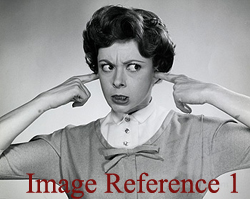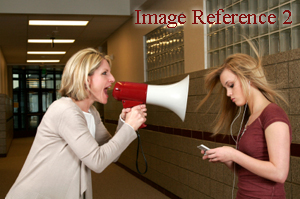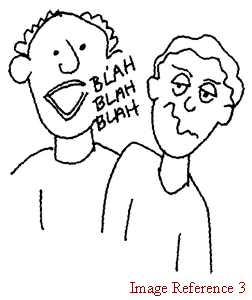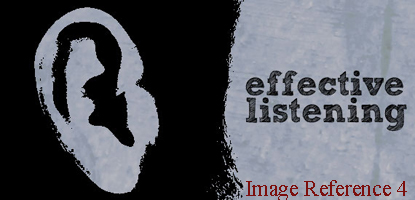Effective Listening

Many people feel that they are good listeners but there is more to being a good listener than simply hearing what a person has to say. The ability to listen effectively is an obvious and important part of the communication process. Research suggests that during the average conversation we only remember 25%-50% of what we hear (Mind Tools Ltd, 2012). This is an evident cause of many miscommunications we experience in everyday life.
When you are able to listen effectively, you build a deeper connection with the speaker because they feel understood and heard; this creates or builds upon a relationship where it is considered safe to express ideas, feelings, plans, opinions, or problems. It also saves time by avoiding misunderstandings and numerous clarifying statements. Most importantly, effective listening can help diffuse emotionally explosive situations. If the conversation is difficult, ensuring the other person feels understood can take a long step to reducing their frustrations and ensuring the conversation runs more smoothly (Robinson, Segal, & Segal, 2012).
So How Can I Be a Good Listener?
There are several things you can do to increase your effective listening.
 The first important one is to give your full attention to the speaker (Pearson Education, 2012). This means controlling your body language. You should face the person, maintain good eye contact without making them feel uncomfortable, and disengage yourself from other things in your environment (such as the TV or activity you were engaged in prior to the conversation) (Cortright, 2012). Keep your body language relaxed and open, avoid crossing your arms or hunching yourself together.
The first important one is to give your full attention to the speaker (Pearson Education, 2012). This means controlling your body language. You should face the person, maintain good eye contact without making them feel uncomfortable, and disengage yourself from other things in your environment (such as the TV or activity you were engaged in prior to the conversation) (Cortright, 2012). Keep your body language relaxed and open, avoid crossing your arms or hunching yourself together.
Keep your mind focused to ensure you are not missing any of the conversation (Pearson Education, 2012). You can ask yourself mental questions about what the speaker is saying to keep yourself on track with the conversation (University of Minnesota Duluth, 2011).

Do not interrupt the speaker before they are done. Give them the opportunity to say everything they wish to say without pause (Pearson Education, 2012). This places the speaker at ease since they will not feel as though they need to fight to get their points across. It is also important that while they are speaking that you are actually allowing yourself to listen and not just focusing on your reply for when they are done (Pearson Education, 2012). Once the speaker has finished, and before you begin your reply, validate what you have heard by paraphrasing and clarifying using statements such as, "So do I understand you correctly that you.." or "Is this what you mean?" (Mind Tools Ltd, 2012). This communicates to the speaker that you have heard what they are trying to say and also gives the opportunity for correction of any misunderstandings.
Once the speaker is done, you are free to respond appropriately by being clear, honest, and concise about your response and opinions. It is important to treat the speaker with respect, as you would want to be treated, in your response (Mind Tools Ltd, 2012).

Good listening skills takes time and practice to build and can be particularly difficult in highly emotional situations. Remember to take the time to calm yourself for a moment if needed. If you feel your emotions are running high then ask the speaker for a brief second to collect yourself and take a deep breath. If you feel the need for this, be sure not to interrupt the speaker in the middle of a point or be disrespectful in the request in order to avoid escalating the situation.
Think you are a good listener? See how your listening skills are by taking this test
Recommended Reading
These books have been read and reviewed by Keeping it Kinky and we recommend them as resources in the area of communication
Article References
Cortright, S. M. (2012). 10 Tips of Effective & Active Listening Skills. Retrieved 09 21, 2012, from Power to Change: http://powertochange.com/students/people/listen/
Mind Tools Ltd. (2012). Active Listening: Hear what people are really saying. Retrieved 09 21, 2012, from MindTools: http://www.mindtools.com/CommSkll/ActiveListening.htm
Pearson Education. (2012). Listening Skills. Retrieved 09 21, 2012, from InfoPlease: http://www.infoplease.com/homework/listeningskills1.html
Robinson, L., Segal, J., & Segal, R. (2012). Effective Communication. Retrieved 09 21, 2012, from HelpGuide.org: http://www.helpguide.org/mental/effective_communication_skills.htm
University of Minnesota Duluth. (2011, 06 16). Listening Skills. Retrieved 09 21, 2012, from UMD Student Handbook: http://www.d.umn.edu/kmc/student/loon/acad/strat/ss_listening.html
Image References
Someone else's art deserves recognition! The images presented in this article were borrowed from the following places:
Header Image: http://togetherforlifeonline.com/wp-content/uploads/2012/11/effective-listening-300.jpg | Retrieved April 25, 2015
Image 1: http://cte.uwaterloo.ca/media/images/generic/Effective%20Communication%20Barriers%20and%20Strategies.jpg | Retrieved September 21, 2012
Image 2: http://1.bp.blogspot.com/-9EwvPx1Tz_w/UDrFSDV3EtI/AAAAAAAAAU8/BB8punUxaDA/s1600/active-listening-not.jpg | Retrieved September 21, 2012
Image 3: http://newthoughtgeneration.com/Brian-Images/how-to-be-a-good-listener.gif | Retrieved September 21, 2012
Image 4: http://nwbingham.com/wp-content/uploads/2011/08/effectivelistening.jpg | Retrieved September 21, 2012

